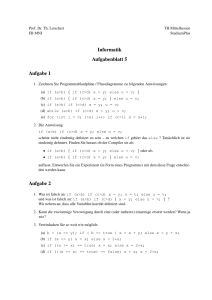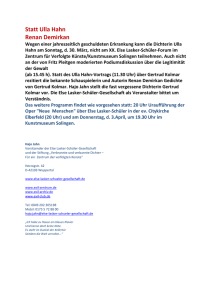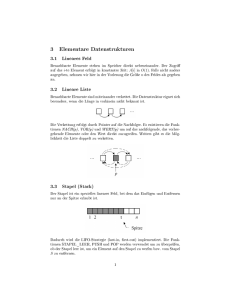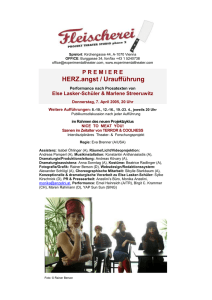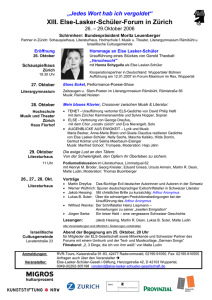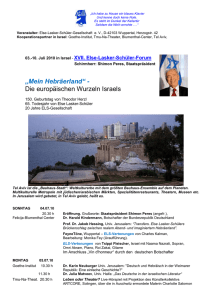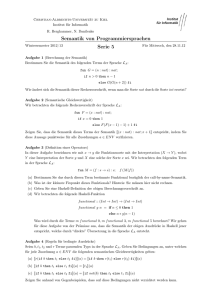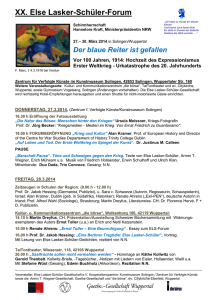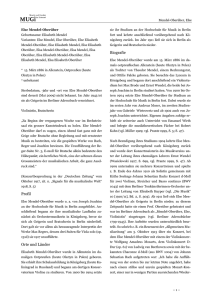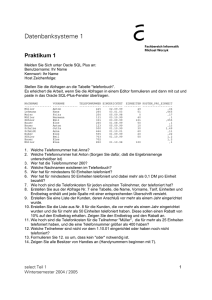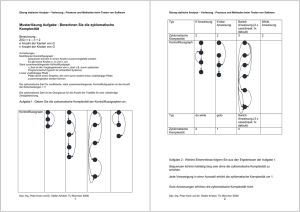Steuerungsprogramme zweier Gene
Werbung
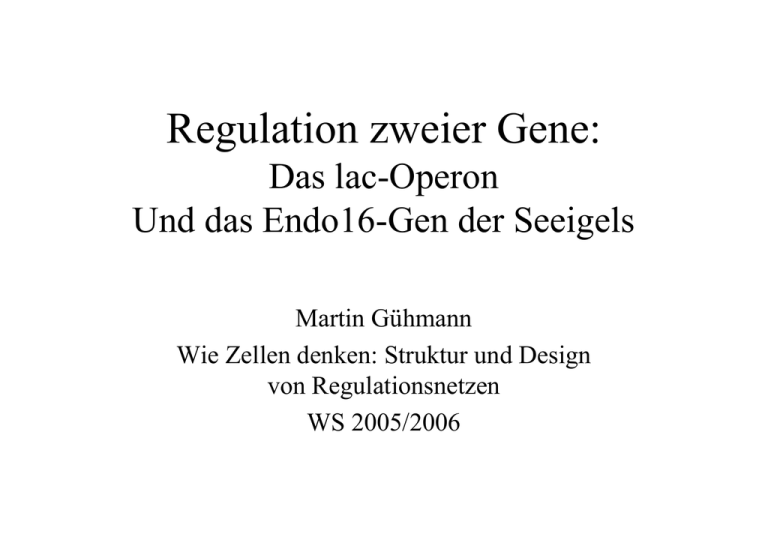
Regulation zweier Gene: Das lac-Operon Und das Endo16-Gen der Seeigels Martin Gühmann Wie Zellen denken: Struktur und Design von Regulationsnetzen WS 2005/2006 Detailed Map of a Cis-Regulatory Input Function Y. Setty, A.E. Mayo, M.G. Surette ad U. Alon PNAS: 100(13) 7702 - 7707 (2003) Influence of Catabolite Repression and Inducer Exclusion on the Bistable Behavior of the lac Operon Moisés Santillán and Michael C. Mackey Biophysical Journal: 86 1282 - 1292 (2004) Regulationsfunktionstypen Regulatorische Elemente des lac-Operons Repression des lac-Operons LacI O3 O3 O2 O1 O1 O2 O3 O1 GFP-Plasmid-System versus Kolorimetrischer Assay • Benutzt GFP • Zusätzliche Plasmide • Kontinuierliche Messung • Keine Zelllyse lac-Operon GFP • Kol. A. misst LacZKonzentration • Keine zusätzlichen Plasmide notwendig • Zelllyse zur Messung nötig. • Beides FluoreszenzMessmethoden Einfaches Modell der lac-RegulatorRegion f = α [ SP ] + β [ SPC ] + γ ([ S ] + [ SC ] + [ SR]) αa + 2β bdΑ + γ (cΛ + dΑ + 1) f = 1 + a + (2b + 1)dΑ + cΛ [C ] Xn Α= = , [CT ] (1 + X n ) X= [cAMP] K cAMP [ R] [ IPGT ] Ym Λ= = , Y= m [ RT ] (1 + Y ) K IPGT T: total , n, m: Hillkoeffizienten [ P] [ P] [R ] [C ] , b= , c= T , d = T a= KP K CP KR KC IPGT: Isopropyl-β-D-Thiogalaktosid CRP: cAMP-Rezeptor-Protein Promotoraktivität während des Zellzyklusses lac-cis-regulatorische Eingangsfunktion (GFP-gemessena) lac-Eingangsfunktion (klorometrisch) und Laktosepromotoraktivität (GFP) Lac-Regulationsmodell versus UND- und ODER-Modell Genomic Cis-Regulatory Logic: Experimental and Computational Analysis of a Sea Urchin Gene Chiou-Hwa Yuh, Hamid Bolouri, Eric H. Davidson Science: 279 1896 - 1902 (1998) Endo16-Expression Endo16: Protein, sekretiert im Mitteldarm des späten Embryos und der Larve Späte Seeigel Blastula AP: Animaler Pol B: Blastocoel VP: Vegetativer Pol Seeigellarve Blau: Exoderm Rot: Mesoderm Gelb: Endoderm http://www.zum.de/Faecher/Materialien/hupfeld/index.htm?/Faecher/Materialien/hupfeld/Inhalt-Entwicklung.html Endo16 cis-Regulationssystem Endo16 cis-Regulationssystem A B C Das Modell: Eine Übersicht 105 CAT Molekühle pro Embryo Interaktion zwischen Modul A und B CAT: Chloramphenikol-Acetyl-Transferase A B C D Stunden nach Befruchtung Expressionssteuerung durch CG1und P-Stelle • • • • • if (P == 1 and CG1 == 1) β := 2 // Halbe Erklärung des Effektes else β := 0 δ(t) := B(t) + G(t) ε(t) := β* δ(t) Expressionsaktivität der Z- und der Otx-Stelle A C Stunden nach Befruchtung 105 CAT Molekühle pro Embryo B Einfluss der Otx-Stelle auf die Expression • if (ε(t) == 0) • ζ(t) := Otx(t) • elseζ(t) := ε(t) CAT-Aktivität unter LiCl Einfluss: Synergismus mit Modulen D, F oder C Interaktionsmodell zwischen der ZStelle und der Module F, E und DC • • • • • • if (F == 1 or E == 1 or CD == 1) and (Z == 1) α := 1 else α := 0 if (α == 1) η(t) := 0 else η(t) := ζ(t) 105 CAT Molekühle pro Embryo Regulation durch CG2,3,4-Stellen A Stunden nach Befruchtung B Einfluss der CG2,3,4-Stellen • if (CG2 == 1 and CG3 == 1 and CG4 == 1) • γ := 2 • else γ := 1 • θ(t) := γ* η(t) Das Modell: Zusammengefasst if (F == 1 or E == 1 or CD == 1) and (Z == 1) α := 1 else α := 0 if (P == 1 and CG1 == 1) β := 2 else β := 0 if (CG2 == 1 and CG3 == 1 and CG4 == 1) γ := 2 else γ := 1 δ(t) := B(t) + G(t) ε(t) := β* δ(t) if (ε(t) == 0) else if (α == 1) ζ(t) := Otx(t) ζ(t) := ε(t) η(t) := 0 else η(t) := ζ(t) θ(t) := γ* η(t)
